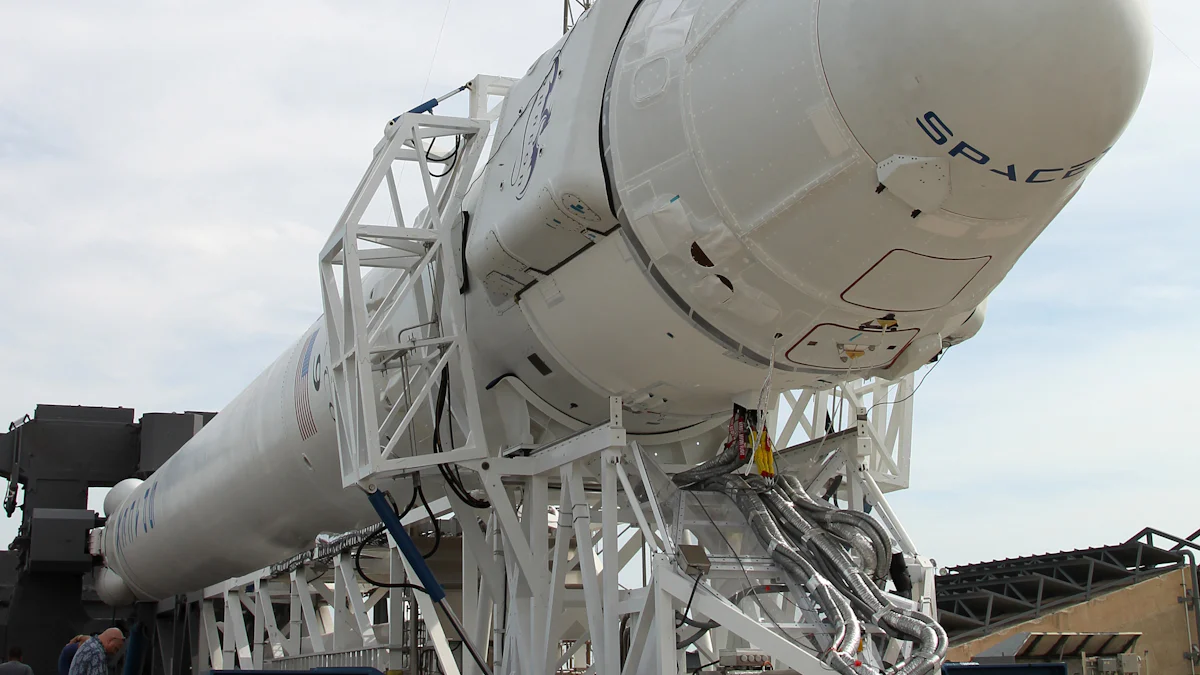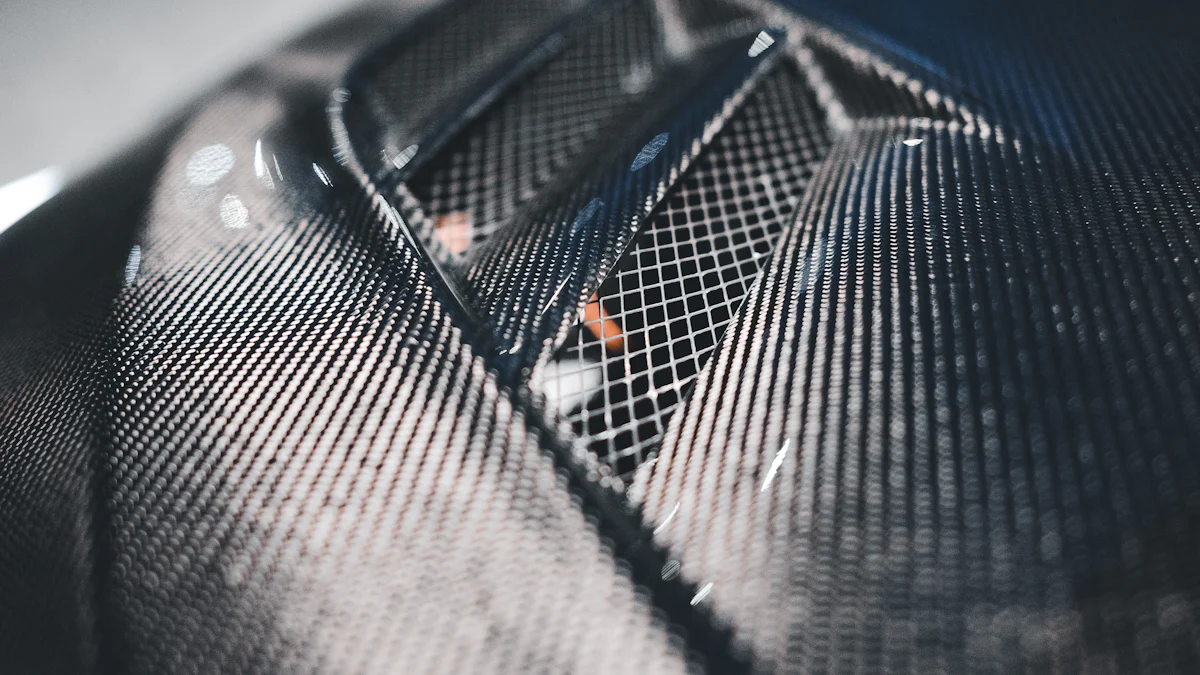
Carbon carbon composites haben mehrere Industrien mit ihren außergewöhnlichen Eigenschaften revolutioniert. Diese Materialien bieten eine unvergleichliche Hochtemperaturstabilität und Festigkeit, was sie in anspruchsvollen Umgebungen unverzichtbar macht. Der Luft- und Raumfahrtsektor setzt sich zum Beispiel stark auf kohlenstoff-verbundwerkstoff materialien für kritische Komponenten. Ebenso profitiert die Automobilindustrie von ihrer leichten und dennoch robusten Natur und verbessert die Fahrzeugleistung. Der globale Markt für Kohlenstoff-Kohlenstoff-Verbundwerkstoffe spiegelt diese wachsende Nachfrage wider, wobei Prognosen einen Anstieg von
21.7 mrd. ecu in 2023
21.7billionin2023χtoχ42,7 Milliarden bis 2033. Dieses Wachstum unterstreicht die zunehmende Abhängigkeit dieser fortschrittlichen Materialien in verschiedenen Anwendungen.
Wichtigste Erkenntnisse
-
- Carbon-carbon composites are wesentlich in der luft- und raumfahrtindustrie, die hohe temperaturstabilität und festigkeit für kritische bauteile wie hitzeschilde und bauteile bietet.
-
- Diese Verbundstoffe im Automobilbereich verbesserung der fahrzeugleistung durch gewichtsreduzierung und verbesserung der wärmemanagement in bremssystemen und motorkomponenten.
-
- Die Sportindustrie profitiert von Kohlenstoff-Kohlenstoff-Verbundstoffen durch leichte und langlebige Ausrüstung, wie Fahrräder und Golfschläger, die die sportliche Leistung verbessern.
-
- Kohlenstoff-Kohlenstoff-Verbundwerkstoffe werden zunehmend in medizinischen Geräten eingesetzt und bieten Vorteile wie leichte Prothesen und nicht-magnetische Komponenten für bildgebende Geräte.
-
- Im Energiesektor tragen diese Materialien zur Effizienz von Windenergieanlagen bei, indem sie längere Schaufeln und leichtere Gondelkomponenten ermöglichen und die Gesamtleistung steigern.
-
- Die Vielseitigkeit von Kohlenstoff-Kohlenstoff-Verbundwerkstoffen erstreckt sich auf industrielle Anwendungen, wo sie Korrosionsbeständigkeit und thermische Stabilität in Hochtemperaturöfen und chemische Verarbeitung bieten.
-
- Der wachsende Markt für Kohlenstoff-Kohlenstoff-Verbundwerkstoffe, der bis 2033 verdoppelt wird, unterstreicht ihre zentrale Rolle bei der Entwicklung von Technologie und Nachhaltigkeit in mehreren Branchen.
Aerospace Industry

Die Luft- und Raumfahrtindustrie steht als Beweis für die bemerkenswerten Fähigkeiten carbon-carbon composites. Diese Materialien sind aufgrund ihrer einzigartigen Eigenschaften, wie hoher spezifischer Festigkeit, geringer Dichte und ausgezeichneter thermischer Stoßfestigkeit, unverzichtbar geworden. Ihre Anwendung in Flugzeug- und Raumfahrzeugkomponenten unterstreicht ihre kritische Rolle bei der Weiterentwicklung der Luft- und Raumfahrttechnologie.
Flugzeugkomponenten
Hitzeschilde
Kohlenstoff-Kohlenstoff-Verbunde dienen als Rückgrat für Hitzeschilde in Flugzeugen. Diese Schilde schützen wichtige Komponenten vor extremen Temperaturen während des Fluges. Der geringe Wärmeausdehnungskoeffizient des Materials sorgt für eine minimale Verformung bei thermischer Belastung, wodurch die strukturelle Integrität erhalten bleibt. Dies macht Kohlenstoff-Kohlenstoff-Verbunde ideal für den Einsatz in Hochgeschwindigkeitsflugzeugen, wo Temperaturschwankungen signifikant sind.
Strukturelle Komponenten
Flugzeuge verlassen sich auf Kohlenstoff-Kohlenstoff-Verbunde für verschiedene Bauteile. Die hohe spezifische Festigkeit und der Modul des Materials sorgen für die notwendige Unterstützung bei gleichzeitigem Leichtbau. Diese Balance von Festigkeit und Gewichtsreduktion verbessert die Kraftstoffeffizienz und Leistung. Kohlenstoff-Kohlenstoff-Verbundwerkstoffe bieten auch eine ausgezeichnete Beständigkeit gegen Müdigkeit und Korrosion, die für Langlebigkeit und Zuverlässigkeit bei anspruchsvollen Bedingungen sorgt.
Anwendungen für Raumfahrzeuge
Wiedereinfahrtsfahrzeuge
Bei der Rückkehr in die Atmosphäre der Erde werden die Fahrzeuge mit hoher Hitze und Druck konfrontiert. Kohlenstoff-Kohlenstoff-Verbundwerkstoffe sind entscheidend für die Konstruktion dieser Fahrzeuge aufgrund ihrer überlegenen Ablationseigenschaften. Sie widerstehen den extremen Bedingungen des Wiedereintritts, des Schutzes des Raumfahrzeugs und seiner Insassen. Die thermische Stoßfestigkeit des Materials sorgt weiter dafür, dass es bei schnellen Temperaturänderungen stabil bleibt.
Satellitenstrukturen
Satelliten profitieren von der leichten und langlebigen Natur von Kohlenstoff-Kohlenstoff-Verbundwerkstoffen. Diese Materialien reduzieren das Gesamtgewicht der Satellitenstrukturen, wodurch effizientere Starts und erweiterte Betriebslebensdauern ermöglicht werden. Die Widerstandsfähigkeit der Verbundwerkstoffe gegen thermische Belastung und Strahlungsabsorption macht sie ideal für die raue Umgebung des Raumes, um sicherzustellen, dass Satelliten während ihrer Missionen optimal funktionieren.
Automotive Industry
Die automobilindustrie hat Kohlenstoff-Kohlenstoff-Verbundwerkstoffe für ihre bemerkenswerten Eigenschaften, transformiert Fahrzeugleistung und Effizienz. Diese Materialien bieten ein hohes Festigkeits-zu-Gewichts-Verhältnis, Korrosionsbeständigkeit und ausgezeichnete Arbeitsfähigkeit, so dass sie ideal für verschiedene Automobilanwendungen.
Hochleistungsfahrzeuge
Hochleistungsfahrzeuge erfordern Materialien, die extremen Bedingungen standhalten können und gleichzeitig Geschwindigkeit und Agilität erhöhen. Kohlenstoff-Kohlenstoff-Verbunde erfüllen diese Anforderungen mit Leichtigkeit.
Brake Systems
Kohlenstoff-Kohlenstoff-Verbundwerkstoffe revolutionieren Bremssysteme in Hochleistungsfahrzeugen. Ihre hohe Wärmeleitfähigkeit und Stabilität sorgen für eine effiziente Wärmeableitung bei der Bremsung, wodurch das Risiko von Bremsblenden reduziert wird. Dies führt auch unter intensiven Bedingungen zu einer gleichbleibenden Bremsleistung. Die Leichtigkeit dieser Verbundwerkstoffe trägt auch zu einem reduzierten ungefederten Gewicht bei, was die Handhabung und Reaktionsfähigkeit verbessert.
Motorkomponenten
Motorkomponenten profitieren deutlich von Kohlenstoff-Kohlenstoff-Verbundwerkstoffen. Diese Materialien bieten eine überlegene Festigkeit und thermische Beständigkeit, so dass Motoren bei höheren Temperaturen arbeiten, ohne die Integrität zu beeinträchtigen. Dies erhöht die Motoreffizienz und die Leistung. Darüber hinaus sorgen die korrosionsbeständigen Eigenschaften von Kohlenstoff-Kohlenstoff-Verbundwerkstoffen auch in rauen Umgebungen für Langlebigkeit und Zuverlässigkeit.
Elektrofahrzeuge
Elektrofahrzeuge (EVs) priorisieren Effizienz und Nachhaltigkeit. Kohlenstoff-Kohlenstoff-Verbundwerkstoffe spielen bei der Erreichung dieser Ziele eine entscheidende Rolle, indem sie Leichtbaulösungen anbieten, die keine Kompromisse bei Festigkeit oder Sicherheit darstellen.
Batteriegehäuse
Batteriegehäuse in EVs erfordern Materialien, die Schutz und Wärmemanagement bieten. Kohlenstoff-Kohlenstoff-Verbunde zeichnen sich durch ihre ausgezeichnete Wärmeleitfähigkeit und strukturelle Integrität aus. Sie helfen, optimale Batterietemperaturen zu halten, Leistung und Lebensdauer zu verbessern. Die Leichtigkeit dieser Verbundwerkstoffe trägt auch zur Gesamteffizienz des Fahrzeugs bei, indem das Gewicht reduziert und die Reichweite verbessert wird.
Leichte Strukturen
Leichte Strukturen sind wesentlich, um die Effizienz von Elektrofahrzeugen zu maximieren. Kohlenstoff-Kohlenstoff-Verbunde bieten eine perfekte Lösung mit ihrem hohen Festigkeits-zu-Gewicht-Verhältnis. Sie ermöglichen die Konstruktion von leichten, aber robusten Fahrzeugrahmen und Komponenten, die den Energieverbrauch und die Reichweite reduzieren. Dies macht Kohlenstoff-Kohlenstoff-Verbundwerkstoffe zu einer bevorzugten Wahl für Hersteller, die effiziente und nachhaltige Elektrofahrzeuge herstellen wollen.
Sportausrüstung

Die Sportindustrie hat eine transformative Verschiebung mit der Integration der Kohlefasertechnologie erlebt. Diese Weiterentwicklung hat nicht nur die Qualität des Sportgerätes verbessert, sondern auch die sportliche Leistungsfähigkeit deutlich verbessert. Kohlenstoff-Verbundwerkstoffe, bekannt für ihre überlegene Festigkeit und Leichtigkeit, haben sich in der Gestaltung moderner Sportgeräte zu einem Grundstein entwickelt.
Fahrräder
Rahmen
Fahrradrahmen aus Kohlenstoffverbunden bieten eine unvergleichliche Kombination aus Festigkeit und Leichtigkeit. Diese Rahmen bieten Radfahrern die Möglichkeit, schnell zu beschleunigen und hohe Geschwindigkeiten mit weniger Aufwand zu halten. Die Steifigkeit von Kohlenstoff-Verbundwerkstoffen sorgt für eine effiziente Kraftübertragung vom Fahrer auf die Räder und erhöht die Gesamtleistung. Darüber hinaus trägt die Haltbarkeit dieser Materialien zur Langlebigkeit des Fahrrades bei und macht sie zu einer bevorzugten Wahl für Profi- und Amateurradfahrer.
Räder
Kohlenstoff-Verbundräder haben das Radfahren revolutioniert, indem das Rotationsgewicht reduziert und die Aerodynamik verbessert wird. Cyclisten profitieren von erhöhter Geschwindigkeit und Agilität, vor allem in wettbewerbsfähigen Einstellungen. Die Leichtigkeit dieser Räder ermöglicht eine schnellere Beschleunigung und ein leichteres Klettern, während ihre strukturelle Integrität Stabilität und Sicherheit gewährleistet. Dadurch sind Kohlenstoff-Verbundräder zu einem entscheidenden Bestandteil für diejenigen geworden, die ihr Fahrraderlebnis optimieren wollen.
Golf Clubs
Wellen
Golfschläger aus Carbon Composites bieten Golfspielern eine verbesserte Kontrolle und Präzision. Die Leichtbaueigenschaften dieser Wellen ermöglichen schnellere Schwinggeschwindigkeiten, was zu einer größeren Entfernung und Genauigkeit führt. Golfer können aufgrund der reduzierten Vibration und erhöhter Stabilität durch Kohlenstoff-Verbunde eine konsequentere Schwingung erreichen. Diese technologische Weiterentwicklung hat Kohlenstoff-Verbundwellen zu einer beliebten Wahl sowohl unter professionellen als auch Freizeit Golfer gemacht.
Club Heads
Carbon Composite Club Köpfe bieten eine einzigartige Mischung aus Power und Finesse. Die Stärke des Materials ermöglicht einen größeren süßen Fleck und erhöht die Vergebung auf außermittige Hits. Golfer erleben verbesserte Ballgeschwindigkeit und Trajektorie, was zu einer besseren Gesamtleistung auf dem Kurs führt. Die Leichtigkeit von Kohlenstoff-Verbundwerkstoffen ermöglicht es den Designern auch, Gewicht innerhalb des Club-Kopfes neu zu verteilen, Balance und Kontrolle zu optimieren. Diese Innovation hat das Spiel für viele Golfer erhöht, bietet ihnen die Werkzeuge, die benötigt werden, um zu übertreffen.
Industrial Applications
Kohlenstoff-Kohlenstoff-Verbundwerkstoffe sind aufgrund ihrer außergewöhnlichen Eigenschaften für verschiedene industrielle Anwendungen integral. Diese Materialien bieten hohe thermische Beständigkeit, geringe Dichte und ausgezeichnete mechanische Festigkeit, so dass sie ideal für anspruchsvolle Umgebungen.
Hochtemperatur-Fäden
Hochtemperaturöfen benötigen Materialien, die extremen Bedingungen ohne Abbau standhalten können. Kohlenstoff-Kohlenstoff-Verbunde zeichnen sich in diesem Bereich aus und bieten sowohl Isolation als auch strukturelle Unterstützung.
Isolierung
Bei Hochtemperaturöfen ist die Isolation entscheidend, um Effizienz und Sicherheit zu erhalten. Kohlenstoff-Kohlenstoff-Verbunde bieten überlegene Wärmedämmeigenschaften, reduzieren Wärmeverlust und Energieeinsparung. Ihre geringe Wärmeleitfähigkeit sorgt dafür, dass der Ofen Wärme behält, die Leistung optimiert und die Betriebskosten minimiert. Dies macht Kohlenstoff-Kohlenstoff-Verbunde eine bevorzugte Wahl für Industrien, die die Ofeneffizienz verbessern wollen.
Strukturelle Unterstützungen
Strukturstützen in Hochtemperaturöfen müssen unter Beibehaltung der Integrität intensive Wärme ertragen. Kohlenstoff-Kohlenstoff-Verbunde bieten die notwendige Festigkeit und Stabilität, um sicherzustellen, dass die Ofenstruktur bei thermischer Belastung robust bleibt. Ihre hohe spezifische Festigkeit und Modul ermöglichen den Bau von leichten und dennoch langlebigen Trägern und tragen zur Gesamteffizienz und Langlebigkeit des Ofens bei.
Chemical Processing
Die chemische Verarbeitungsindustrie verlangt Materialien, die Korrosion widerstehen und rauen Umgebungen standhalten können. Kohlenstoff-Kohlenstoff-Verbunde erfüllen diese Anforderungen und bieten Haltbarkeit und Zuverlässigkeit in kritischen Anwendungen.
Korrosionsbeständige Komponenten
Korrosionsbeständige Komponenten sind bei der chemischen Verarbeitung unerlässlich, um Materialabbau zu verhindern und Sicherheit zu gewährleisten. Kohlenstoff-Kohlenstoff-Verbundwerkstoffe zeichnen sich durch eine ausgezeichnete Korrosionsbeständigkeit aus und eignen sich für den Einsatz in aggressiven chemischen Umgebungen. Ihre Fähigkeit, korrosive Substanzen zu widerstehen, verlängert die Lebensdauer der Komponenten, reduziert Wartungskosten und Ausfallzeiten.
Heat Exchangers
Wärmeaustauscher spielen eine wichtige Rolle bei der chemischen Verarbeitung durch Wärmeübertragung zwischen Flüssigkeiten. Kohlenstoff-Kohlenstoff-Verbunde verbessern die Effizienz von Wärmetauschern mit ihrer ausgezeichneten Wärmeleitfähigkeit und Stabilität. Diese Materialien ermöglichen einen effizienten Wärmeübergang, eine Verbesserung der Prozesseffizienz und eine Reduzierung des Energieverbrauchs. Die Haltbarkeit von Kohlenstoff-Kohlenstoff-Verbundwerkstoffen sorgt auch dafür, dass Wärmeaustauscher für längere Zeit betriebsbereit bleiben und der Industrie langfristigen Wert bieten.
Medical Devices
Das medizinische Gebiet hat erhebliche Fortschritte bei der Integration von materialien auf kohlenstoffbasis, insbesondere in der Abbildungstechnik und Prothetik. Diese Materialien bieten einzigartige Eigenschaften, die die Funktionalität und Effizienz von medizinischen Geräten verbessern.
Imaging Equipment
Medizinische Bildgebungsausrüstung erfordert Materialien, die Stabilität, Präzision und Sicherheit bieten. Kohlenstoff-Verbundwerkstoffe sind bei der Konstruktion dieser Geräte integral geworden.
Röntgentische
Röntgentische aus Kohlenstoffverbunden bieten mehrere Vorteile. Ihre leichte Natur ermöglicht eine einfache Manövrierfähigkeit und erhöht die Effizienz der medizinischen Verfahren. Die Radioluzenz des Materials sorgt dafür, dass sie die Röntgenbildgebung nicht beeinträchtigt und klare und genaue Ergebnisse liefert. Diese Eigenschaft minimiert den Bedarf an wiederholten Expositionen, gewährleistet die Patientensicherheit und reduziert die Strahlendosen.
MRI Komponenten
MRT-Maschinen profitieren von Kohlenstoffverbundwerkstoffen aufgrund ihrer nichtmagnetischen Eigenschaften. Diese Materialien stören nicht die Magnetfelder, die in der MRI-Bildgebung verwendet werden, um präzise und zuverlässige Scans zu gewährleisten. Die Festigkeit und Haltbarkeit von Kohlenstoff-Verbundwerkstoffen tragen auch zur Langlebigkeit von MRI-Komponenten bei, wodurch Wartungskosten und Ausfallzeiten reduziert werden. Dies macht sie zu einer bevorzugten Wahl für Hersteller, die hochwertige Bildgebungsgeräte herstellen möchten.
Prothetik
Prothetische Geräte haben sich mit dem Einsatz fortschrittlicher Materialien deutlich weiterentwickelt. Carbon Composites bieten eine Kombination aus Festigkeit, Flexibilität und leichten Eigenschaften, so dass sie ideal für prothetische Anwendungen.
Leichte Limetten
Prothetische Glieder aus Kohlenstoff-Verbundwerkstoffen bieten Benutzern eine verbesserte Mobilität und Komfort. Die Leichtigkeit dieser Materialien reduziert die Energie, die für die Bewegung benötigt wird, und ermöglicht den Anwendern, tägliche Aktivitäten mit Leichtigkeit durchzuführen. Die Festigkeit von Kohlenstoff-Verbundwerkstoffen sorgt dafür, dass die prothetischen Gliedmaßen einem regelmäßigen Einsatz standhalten können, ohne die Leistung zu beeinträchtigen. Diese Innovation hat die Lebensqualität für viele Menschen verbessert, so dass sie aktive und unabhängige Leben führen können.
Langlebige Gelenke
Langlebige Gelenke sind entscheidend für prothetische Geräte, um eine reibungslose und natürliche Bewegung zu gewährleisten. Carbon Composites bieten die notwendige Stärke und Flexibilität, um Gelenke zu schaffen, die die natürliche Bewegung der menschlichen Gliedmaßen imitieren. Diese Materialien bieten eine ausgezeichnete Beständigkeit gegen Verschleiß und verlängert die Lebensdauer von Prothesen. Benutzer profitieren von erhöhter Zuverlässigkeit und Funktionalität, so dass sie in verschiedene körperliche Aktivitäten mit Vertrauen zu engagieren.
Energy Sector
Der Energiesektor hat zunehmend vormaterialien effizienz und Leistungsfähigkeit zu verbessern. Kohlenstoffverbunde, bekannt für ihre hohe Festigkeit und thermische Stabilität, spielen bei dieser Transformation eine zentrale Rolle. Ihre Anwendung in Windenergieanlagen und der Kernindustrie zeigt ihre Vielseitigkeit und Wirksamkeit.
Windkraftanlagen
Windturbinen nutzen erneuerbare Energie, und ihre Effizienz hängt weitgehend von den Materialien ab, die in ihrem Bau verwendet werden. Kohlenstoffverbunde tragen wesentlich zur Leistung dieser Turbinen bei.
Klingen
Windturbinenschaufeln benötigen Materialien, die sowohl Festigkeit als auch Leichtigkeit bieten. Carbon Composites bieten die ideale Lösung. Diese Materialien ermöglichen längere Klingen, die mehr Windenergie aufnehmen und die Leistung erhöhen. Die Leichtigkeit von Kohlenstoff-Verbundwerkstoffen reduziert die Belastung der Turbinenstruktur, verbessert die Haltbarkeit und reduziert den Wartungsbedarf. Diese Weiterentwicklung der Schaufeltechnik hat zu einer effizienteren und zuverlässigeren Windenergieerzeugung geführt.
Nacelle Komponenten
Die Gondel beherbergt kritische Komponenten einer Windenergieanlage, einschließlich Generator und Getriebe. Carbon Composites bieten ausgezeichnete Wärmeleitfähigkeit und strukturelle Integrität, so dass sie für nacelle Komponenten geeignet. Diese Materialien helfen, die im Betrieb erzeugte Wärme abzuführen und gewährleisten eine optimale Leistung und Langlebigkeit. Der Einsatz von Kohlenstoff-Verbundwerkstoffen in Gondeln trägt ebenfalls zur Gewichtsreduktion bei, was die Effizienz und Stabilität der Turbine verbessert.
Kernenergie
Die Kernindustrie verlangt Materialien, die extremen Bedingungen standhalten können und gleichzeitig Sicherheit und Zuverlässigkeit gewährleisten. Carbon Composites erfüllen diese Anforderungen und bieten Lösungen für kritische Anwendungen.
Reactor Komponenten
Kernreaktoren arbeiten unter hohen Temperaturen und Strahlungsniveau. Carbon Composites bieten eine überlegene thermische Beständigkeit und mechanische Festigkeit, so dass sie ideal für Reaktorkomponenten. Diese Materialien bewahren ihre Integrität unter extremen Bedingungen auf und gewährleisten den sicheren und effizienten Betrieb von Kernreaktoren. Die Haltbarkeit von Kohlenstoff-Verbundwerkstoffen reduziert auch die Häufigkeit der Wartung und des Austauschs und trägt zur langfristigen Nachhaltigkeit von Kernkraftwerken bei.
Strahlenschutzschilde
Strahlenschutzschilde schützen Personal und Geräte vor schädlicher Strahlenexposition. Kohlenstoffverbunde bieten eine effektive Abschirmung aufgrund ihrer hohen Dichte und Stabilität. Diese Materialien absorbieren und dissipieren Strahlung, minimieren die Exposition und gewährleisten Sicherheit. Die Leichtigkeit von Kohlenstoff-Verbundwerkstoffen ermöglicht das Design von tragbaren und flexiblen Abschirmlösungen, die ihre Anwendbarkeit in verschiedenen Kerneinstellungen verbessern.
Kohlenstoff-Kohlenstoff-Verbundwerkstoffe sind in der modernen Technik als Eckpfeiler entstanden und zeigen ihre Vielseitigkeit in verschiedenen Branchen. Ihre hohe mechanische Festigkeit, geringes Gewicht und überlegene Beständigkeit gegenüber thermischer Belastung machen sie in den Bereichen Luft- und Raumfahrt, Automobil- und Sportgeräte unverzichtbar. Diese Materialien verbessern nicht nur die Leistung, sondern auch die technologischen Fortschritte, indem traditionelle Metalle durch leichte Alternativen ersetzt werden. Die zunehmende Abhängigkeit von Kohlenstoff-Kohlenstoff-Verbundwerkstoffen unterstreicht ihre zentrale Rolle bei der Gestaltung der Zukunft von leistungsstarken Anwendungen, um Effizienz und Nachhaltigkeit zu gewährleisten.
FAQ
Woraus bestehen Kohlenstoff-Kohlenstoff-Verbunde?
Kohlenstoff-Kohlenstoff-Verbunde bestehen aus kohlenstofffasern eingebettet in eine Kohlenstoffmatrix. Diese Verbunde reichen von einfachen unidirektionalen faserverstärkten Strukturen bis hin zu komplexen gewebten dreidimensionalen Strukturen. Die Vielfalt an Carbonfasern und multidirektionalen Webtechniken ermöglicht es, diese Composites auf komplexe Designanforderungen zuzuschneiden. Durch die Auswahl des Fasertyps, des Auflegens (oder der Faserbindung), der Matrix und der Verbundwärmebehandlung können die Hersteller den Eigenschaften unterschiedlicher Anwendungen entsprechen.
Warum werden Kohlenstoff-Kohlenstoff-Verbundwerkstoffe in Hochtemperaturanwendungen eingesetzt?
Kohlenstoff-Kohlenstoff-Verbunde in high-temperature applications aufgrund ihrer außergewöhnlichen thermischen Stabilität und Beständigkeit gegen thermischen Schock. Diese Materialien halten ihre strukturelle Integrität unter extremer Hitze, so dass sie ideal für Luft- und Industrieanwendungen, wo hohe Temperaturen vorherrschen.
Wie verbessern Kohlenstoff-Kohlenstoff-Verbunde die Fahrzeugleistung?
In der Automobilindustrie verbessern Kohlenstoff-Kohlenstoff-Verbundwerkstoffe die Fahrzeugleistung durch ein hohes Festigkeits-Gewichtsverhältnis. Diese Eigenschaft reduziert das Gesamtgewicht von Fahrzeugen, erhöht Geschwindigkeit, Agilität und Kraftstoffeffizienz. Darüber hinaus bieten diese Verbundwerkstoffe eine ausgezeichnete Wärmeleitfähigkeit, die für Hochleistungsbremssysteme von entscheidender Bedeutung ist.
Sind Kohlenstoff-Kohlenstoff-Verbundwerkstoffe umweltfreundlich?
Kohlenstoff-Kohlenstoff-Verbundwerkstoffe tragen zur ökologischen Nachhaltigkeit bei, indem das Gewicht von Fahrzeugen und Flugzeugen reduziert wird, was zu einem geringeren Kraftstoffverbrauch und Emissionen führt. Ihre Haltbarkeit und Langlebigkeit minimieren auch den Bedarf an häufigen Austauschen, reduzieren Abfall und Ressourcenverbrauch.
Was macht Kohlenstoff-Kohlenstoff-Verbundwerkstoffe für Sportgeräte geeignet?
Kohlenstoff-Kohlenstoff-Verbundwerkstoffe sind aufgrund ihrer leichten und starken Natur ideal für Sportgeräte. Diese Eigenschaften ermöglichen die Schaffung von Getriebe, die sportliche Leistung durch bessere Kontrolle, Geschwindigkeit und Haltbarkeit verbessert. Zum Beispiel profitieren Fahrräder und Golfclubs deutlich von diesen fortschrittlichen Materialien.
Kann Kohlenstoff-Kohlenstoff-Verbunde in medizinischen Geräten verwendet werden?
Ja, Kohlenstoff-Kohlenstoff-Verbunde werden in medizinischen Geräten verwendet, insbesondere in der Abbildungstechnik und Prothetik. Ihre nicht-magnetischen Eigenschaften machen sie geeignet für MRI-Komponenten, während ihre leichte und langlebige Natur die Funktionalität von Prothesenschenkeln erhöht.
Wie tragen Kohlenstoff-Kohlenstoff-Verbundwerkstoffe zu erneuerbaren Energien bei?
Im Energiesektor spielen Kohlenstoff-Kohlenstoff-Verbundwerkstoffe eine entscheidende Rolle in Windenergieanlagen. Sie bieten die notwendige Festigkeit und Leichtigkeit für Turbinenschaufeln, die Effizienz und Leistungsabgabe erhöhen. Diese Materialien verbessern auch die Haltbarkeit und Leistung von nacelle Komponenten und tragen zu einer zuverlässigeren Windenergieproduktion bei.
Welche Vorteile hat der Einsatz von Kohlenstoff-Kohlenstoff-Verbundwerkstoffen in der Kernindustrie?
Kohlenstoff-Kohlenstoff-Verbunde bieten in der Kernindustrie aufgrund ihrer überlegenen thermischen Beständigkeit und mechanischen Festigkeit erhebliche Vorteile. Sie halten die Integrität unter extremen Bedingungen aufrecht und machen sie ideal für Reaktorkomponenten und Strahlungsschilde. Diese Eigenschaften gewährleisten einen sicheren und effizienten Betrieb in nuklearen Einstellungen.
Wie widerstehen Kohlenstoff-Kohlenstoff-Verbundwerkstoffe Korrosion in der chemischen Verarbeitung?
Kohlenstoff-Kohlenstoff-Verbundwerkstoffe zeichnen sich durch eine ausgezeichnete Korrosionsbeständigkeit aus und eignen sich für den Einsatz in aggressiven chemischen Umgebungen. Ihre Fähigkeit, korrosive Substanzen zu widerstehen, verlängert die Lebensdauer von Komponenten, reduziert Wartungskosten und Ausfallzeiten in chemischen Verarbeitungsanwendungen.
Was ist der Zukunftsausblick für Kohlenstoff-Kohlenstoff-Verbunde?
Die Zukunftsaussichten für Kohlenstoff-Kohlenstoff-Verbundwerkstoffe sind vielversprechend, mit steigender Nachfrage in verschiedenen Branchen. Ihre einzigartigen Eigenschaften fahren weiterhin technologische Fortschritte, ersetzen traditionelle Materialien durch leichte Alternativen. Da Industrien Effizienz und Nachhaltigkeit suchen, wird die Abhängigkeit von Kohlenstoff-Kohlenstoff-Verbundwerkstoffen voraussichtlich deutlich wachsen.